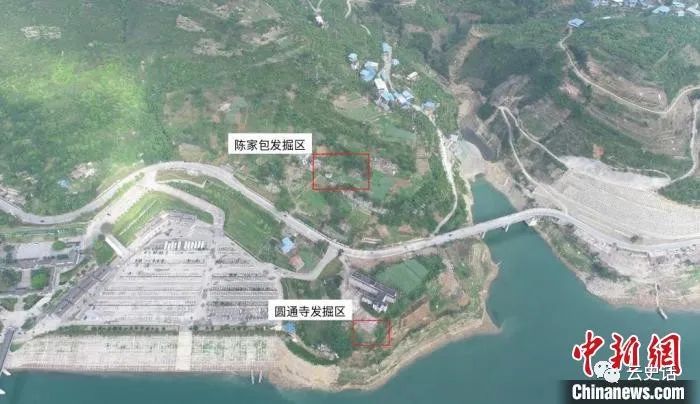In the Ming Dynasty, guard stations were set up all over the country.
The picture is from Chongqing Institute of cultural relics and archaeology.
It is located in Ziyang village, Baidi Town, Fengjie County, Chongqing and qutangxia community of Kuimen sub district office.
According to the characteristics of blue and white porcelain bowls unearthed in the soil cushion and waste accumulation, this group of buildings were built in the middle and late Ming Dynasty and abandoned in the Chongzhen period of the Ming Dynasty.
It is reported that the main building of the Ming Dynasty building site is five rooms wide and three rooms deep.
Following the planning principle of “sleeping in the former dynasty” and taking the corridor as the axis, it looks like the architectural layout of “I-shaped hall”.
It was learned from Chongqing Institute of cultural relics and archaeology that during the archaeological excavation of the follow-up large site protection project of the Three Gorges in 2021, the archaeological team found a large-scale building foundation site of weiyouqianhu Institute of Qutang in the Ming Dynasty in the site of Baidi city in Fengjie.
In six months, the archaeological team excavated 2350 square meters, The most important thing is to discover and expose one large-scale building base site of the Ming Dynasty in the chenjiabao excavation area of the site.
“Wei” and “Suo” were important military units in the Ming Dynasty.
The foundation site of chenjiabao building is located in the northwest and Southeast.
Sun Zhigang said that the Wei Suo system was a unique military system created by the rulers of the Ming Dynasty based on the military system of the Tang Dynasty.
From south to north, there are four-level abutment foundations raised step by step.
The foundation sites of the buildings are all rammed earth wrapped stone abutment buildings.
Source: China news network..
The core building of Qutang Weiyou qianhusuo in chenjiabao excavation area.
All around is not to the boundary of the foundation site, and the building volume is large.
This is the first discovery of the Wei Suo building of the Ming Dynasty in Chongqing.
The north, East and west sides of the periphery of the abutment are surrounded by high abutment foundation sites to form a two-way closed courtyard layout.
The longest part in the north and south is 45 meters, and the widest part in the East and West is 46 meters.
The central axis corridor is consciously left.
According to the history of the Ming Dynasty, there were 329 internal and external guards and 65 guard stations for thousands of households in the twenty sixth year of Hongwu.
Landform before archaeological excavation of Baidicheng site (local).
Sun Zhigang said that the discovery of the weiyouqianhu station in Qutang in the Ming Dynasty not only enriched the materials of the Weisuo station in the Ming Dynasty, but also proved that the Baidi city site has been an important military town guarding the natural danger of Kuimen since the Han, six dynasties, Tang, song, yuan and Ming dynasties, further enriched the connotation of the Baidi city site and highlighted the important strategic position of Baidi city in history.
With the establishment of Wei Suo, around the command center of Wei Suo, they chose places to build cities and garrison troops, forming a complete management system.
The picture comes from the Baidi city site of Chongqing Institute of cultural relics and archaeology.
The front and rear two-level abutment foundations form one courtyard respectively.
It is built by plastering the ground with square bricks and strips of bricks, combined with relevant historical materials and the inscription of “rebuilding the monument of thousands of households on the right side of Qutang Wei” preserved in front of the building complex, Experts preliminarily identified it as an important part of the office building of the right thousand households of Qutang Weisuo in the Ming Dynasty, which is most likely to be the core buildings such as the hearing hall and the sleeping retreat hall.
45 relics such as house sites, patios, roads and drainage ditches have been cleared, and 371 relics dominated by ceramic ware have been unearthed.
It will provide important material materials for the industry to study the Wei Suo system and the architectural layout and construction of the Wei Suo Office of the Ming Dynasty.

However, according to the current published materials, only a small number of health institutes (cities) such as Wanquan Youwei in Zhangjiakou, Hebei, Xuzhou and Tianjin have carried out archaeological work.
Sun Zhigang, leader of the Baidicheng site archaeological team of Chongqing Institute of cultural relics and archaeology, introduced that the archaeological excavation was to cooperate with the follow-up protection of the Three Gorges site, promote the construction of Baidicheng site park, and further understand the layout and evolution of Baidicheng site.
It is 18 kilometers away from Fengjie new County in the west, facing the Yangtze River in the South and facing the West mouth of qutangxia across the Caotang River in the East.
The architectural planning shows a spatial pattern of narrow on the left and wide on the right.
Preliminary exploration shows that the base area of the building covers an area of more than 6000 square meters, with an excavated area of 1183 square meters.




